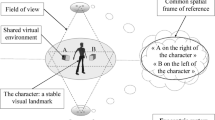Abstract
Collaborative virtual environments (CVEs) are 3D spaces in which users share virtual objects, communicate, and work together. To collaborate efficiently, users must develop a common representation of their shared virtual space. In this work, we investigated spatial communication in virtual environments. In order to perform an object co-manipulation task, the users must be able to communicate and exchange spatial information, such as object position, in a virtual environment. We conducted an experiment in which we manipulated the contents of the shared virtual space to understand how users verbally construct a common spatial representation of their environment. Forty-four students participated in the experiment to assess the influence of contextual objects on spatial communication and sharing of viewpoints. The participants were asked to perform in dyads an object co-manipulation task. The results show that the presence of a contextual object such as fixed and lateralized visual landmarks in the virtual environment positively influences the way male operators collaborate to perform this task. These results allow us to provide some design recommendations for CVEs for object manipulation tasks.














Similar content being viewed by others
Notes
A tetramino is a geometric figure that consists of four cubes, each having at least one side shared with another (Tetris game figures).
References
Bridgeman B (1999) Separate representations of visual space for perception and visually guided behavior. In: Aschersleben G, Bachmann T, Müsseler J (eds) Cognitive contribution to the perception of spatial and temporal events, pp 3–18
Chellali A, Milleville-Pennel I, Dumas C (2008) Elaboration of a common frame of reference in collaborative virtual environments. In: Abascal J, Fajardo I, Oakley I (eds) Proceedings of the 15th European conference on cognitive ergonomics: the ergonomics of cool interaction, Funchal, 16–19 Sept 2008, vol 369, pp 83–90
Churcher N, Churcher C (1996) A collaborative approach to GIS. In: Proceedings of the 8th annual colloquium of the spatial information research centre, pp 156–163
Clark HH (1996) Using language. Cambridge University Press, Cambridge
Clark H, Brennan S (1991) Grounding in communication. In: Resnick L, Levine J, Teasley S (eds) Cognition, perspectives on socially shared. American Psychological Association, Washington, pp 127–149
Dillenbourg P (1999) What do you mean by collaborative learning? In: Dillenbourg P (ed) Collaborative learning: cognitive and computational approaches. Elsevier, Oxford, pp 1–19
Dillenbourg P, Baker M, Blaye A, Malley CO (1996) The evolution of research on collaborative learning. In: Spada E, Reiman P (eds) Learning 117(1):189–211. Elsevier
Erickson T (1993) From interface to interplace: the spatial environment as a medium for interaction. In: Proceedings of the conference on spatial information theory
Gaver B (1992) The affordances of media spaces for collaboration. In: Proceedings of the ACM conference on computer support cooperative work (CSCW), Toronto
Gaver WW, Sellen A, Heath C, Luff P (1993) One is not enough: multiple views in a media space. In: Proceedings of INTERCHI, pp 335–341
Gibson JJ (1979) The ecological approach to visual perception. Houghton Mifflin, New York
Harrison S, Dourish P (1996) Re-place-ing space: the roles of place and space in collaborative systems. In: Proceedings of the 1996 ACM conference on computer supported cooperative work. ACM, pp 67–76
Hindmarsh J, Fraser M, Heath C, Benford S, Greenhalagh C (1998) Fragmented interaction: establishing mutual orientation in virtual environments. In: Proceedings of the ACM 1998 conference on computer-supported cooperative work, pp 217–226
Hindmarsh J, Fraser M, Heath C, Benford S, Greenhalagh C (2000) Object-focused interaction in collaborative virtual environments. ACM Trans Comput Hum Interact 7(4):477–509
Hoc J-M (2001) Towards a cognitive approach to human-machine cooperation in dynamic situations. Int J Hum Comput Stud 54:509–540
Kimura D (2001) Cerveau d’homme et cerveau de femme?. Odile Jacob, Paris
Klingberg T (2006) Development of a superior frontal-intraparietal network for visuo-spatial working memory. Neuropsychologia 44:2171–2177
Kolb B, Whishaw I (2002) Cerveau et comportement. De Boeck Université
Koscik T, O’leary D, Moser DJ, Andreasen NC, Nopoilos P (2009) Sex differences in parietal lobe morphology: relationship to mental rotation performance. Brain Cogn 69:451–459
Lawton CA (2001) Gender and regional differences in spatial referents used in direction giving. Sex Roles 44:321–337
Park K, Kapoor A, Scharver C, Leigh J (2000) Exploiting multiple perspectives in tele-immersion. In: Proceedings of the 4th immersive projection technology workshop, Ames
Roberts R, Aman C (1993) Developmental differences in giving directions: spatial frames of reference and mental rotation. Child Dev 64:1258–1270
Roschelle J, Teasley SD (1995) Construction of shared knowledge in collaborative problem solving. In: O’Malley C (ed) Computer-supported collaborative learning. Springer, New York, pp 69–97
Spante M, Schroeder R, Axelsson AS (2004) How putting yourself into the other person’s virtual shoes enhances collaboration. In: Proceedings of the 7th international workshop on presence, Valencia, pp 190–196
Stefik M, Bobrow DG, Lanning S, Tatar D (1987) WYSIWIS revised: early experiences with multiuser interfaces. ACM Trans Inf Syst 5(2):147–167
Stoakley R, Conway MJ, Pausch R (1995) Virtual reality on a WIM: interactive worlds in miniature. In: Proceedings of human factors and computer systems, pp 265–272
Acknowledgments
We would like to thank students from Ecole Centrale de Nantes and Nantes University who agreed to participate in this experiment. The research was partially funded through InterActeurs project (CRE 43230501) in collaboration with Orange Labs.
Author information
Authors and Affiliations
Corresponding author
Rights and permissions
About this article
Cite this article
Chellali, A., Milleville-Pennel, I. & Dumas, C. Influence of contextual objects on spatial interactions and viewpoints sharing in virtual environments. Virtual Reality 17, 1–15 (2013). https://doi.org/10.1007/s10055-012-0214-5
Received:
Accepted:
Published:
Issue Date:
DOI: https://doi.org/10.1007/s10055-012-0214-5




